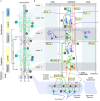Remembrance of things perceived: Adding thalamocortical function to artificial neural networks
- PMID: 36959924
- PMCID: PMC10027940
- DOI: 10.3389/fnint.2023.1108271
Remembrance of things perceived: Adding thalamocortical function to artificial neural networks
Abstract
Recent research has illuminated the complexity and importance of the thalamocortical system but it has been difficult to identify what computational functions it performs. Meanwhile, deep-learning artificial neural networks (ANNs) based on bio-inspired models of purely cortical circuits have achieved surprising success solving sophisticated cognitive problems associated historically with human intelligence. Nevertheless, the limitations and shortcomings of artificial intelligence (AI) based on such ANNs are becoming increasingly clear. This review considers how the addition of thalamocortical connectivity and its putative functions related to cortical attention might address some of those shortcomings. Such bio-inspired models are now providing both testable theories of biological cognition and improved AI technology, much of which is happening outside the usual academic venues.
Keywords: attention; illusion; learning; memory; saliency; thalamus.
Copyright © 2023 Loeb.
Conflict of interest statement
The authors declare that the research was conducted in the absence of any commercial or financial relationships that could be construed as a potential conflict of interest.
Figures


References
-
- Baars B. J. (2007). “The global workspace theory of consciousness,” in The Blackwell Companion to Consciousness, eds Velmans M., Schneider S. (Hoboken, NJ: John Wiley & Sons, Ltd.), 236–246. 10.1002/9781119132363.ch16 - DOI
Publication types
LinkOut - more resources
Full Text Sources

